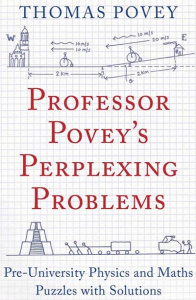Vjera Miović, OAPT Newsletter Editor, TDSB teacher
vjera.miovic@gmail.com
If you are like me, maybe you miss discussing random physics problems with nerdy friends who are scattered around the pandemic-stricken globe. Or you just like interesting puzzles, beyond sudoku and crosswords. Perhaps you are looking for challenging problems for your eager senior students or a contest-prep science club. Here is a good summer read for you:
Professor Povey’s Perplexing Problems, by Thomas Povey (2015).

As the subtitle of the book says, it is filled with pre-university physics and math problems with solutions. The book is organised into chapters, each with its own topic, such as “Statics”, “Dynamics and Collisions”, “Electricity”, “Buoyancy and Hydrostatics”, and more intriguingly titled “Mad Inventions and Perpetual Motion”. Some mathematicians will find it surprising that the “Geometry” chapter is listed separately from the “Mathematics” chapter. The latter offers problems mainly in logic and probability, and Povey, who is a Professor of Engineering Science at the University of Oxford, notes that those problems are more “real-world” applications of mathematics.
Povey introduces the book with “This is a personal book” and goes on to explain that the collection includes “some of [his] favourite … problems in physics and maths”, such as the ones given in university entrance exams in the UK. Following the introduction, we are treated to a mini-memoir of Povey’s adventures from the careless, budding-engineer childhood days to his own university entrance exams.
The problems are written as stories, involving history and various interesting pieces of information, all supported by well-cited evidence. It reads like a personal love-letter to physics, engineering, design, and all kinds of interesting things. Some of the puzzles are: “The Three Door Problem”, a classic ‘which door should you choose’; the “Obelisk raiser”, where the author goes into 3 ½ pages of well-researched history of the ancient monument before presenting the problem to be solved (finding the minimum force required to raise an obelisk); “Dr Lightspeed’s elastotennis match”, where it’s explained that ‘elastotennis’ is a game of tennis where both the ball and the racquet are perfectly elastic; and “Ice in the desert”, which teaches the reader that the use of radiative cooling was around in Persian and ancient Indian ice houses for over two thousand years, and mentions the lucrative ‘ice trade’ in the early 1800s, where profit was made by selling cut ice from the Hudson River near Manhattan to the colonial aristocracy down in the Caribbean. The “Ice in the desert” problem goes as follows: The city sells spheres of ice of any mass. Person A leaves the city with an 800 kg sphere of ice and arrives at point A in the desert with a 100 kg sphere of ice. How much ice should person B get from the city to arrive at point B in the desert, twice the distance from the city as point A, with the same amount of ice as person A (100 kg)? Persons A and B travel at night, so we can ignore the radiation from the sun. You should also need to assume that the temperature of the desert is the same and constant during their travels. I will leave you to ponder the (rather simple) solution and add any assumptions you may need. The book also presents, as almost expected from a puzzle-loving, middle-aged, British prof, a problem which starts with a Monty Python reference regarding the speed of an unladen swallow. The problem itself has nothing to do with swallows and is about two men crossing a deep gorge (which can also be seen as a Monty Python reference from the same film).
A good number of puzzles have post-answer sections titled “further discussion” and “a more elegant approach”, as the problems in the book are generally intended to have open-ended solutions. Most problems in the book are suitable for keen senior high school physics students in Ontario. However, keep in mind that some problems require a basic understanding of calculus.
The main issue I have with the book is the way it’s laid out; the answer to each problem appears directly after the problem has been posed, often on the same page. You just finish reading about this interesting problem, and before you get to catch a breath and start thinking about how you would come up with a solution yourself, your eye inevitably scans the page and sees the equation that provides the answer. You have to be extremely self-disciplined to cover the part of the page with the answer and put the book away immediately after reading the problem, so that you can try to solve it yourself. I recommend having a notebook and pencil ready next to the book – otherwise, you’ll just keep reading. In a potential subsequent edition, I’d love to see the answers at the back of the book, in separate chapters.
If you dare play the “Deadly game of puzzle scores”, for which the rules and scoring are explained at the end of the book, let me know your score! Again, it would have been better if Povey described the game rules earlier in the book, before you potentially have read all the answers already. For more on the book, the puzzles and a forum with readers’ answers, check out www.perplexingproblems.com.
In conclusion, Professor Povey’s Perplexing Problems is a great read for physics minds and educators, whether you read it front to back by yourself, or decide to pick and choose problems for your STEM club and keen physics students. You can find the book at places where you normally buy your books, from the publisher, or ready to borrow from your public library (Toronto Public Library has it).
ReferencePovey, T. (2015).
Professor Povey's perplexing problems: pre-university physics and maths puzzles with solutions. Oneworld.


